Palm Agriculture: Analyzing Article 5 of the Paris Agreement (2015)
VerifiedAdded on 2023/06/15
|14
|3640
|210
Report
AI Summary
This report provides an executive summary of global climate change and its adverse impacts on the environment. It focuses on the role of international law, particularly Article 5 of the Paris Agreement, in mitigating climate change related to palm agriculture in Malaysia and Indonesia. The report discusses the challenges of sustainable palm oil cultivation, including deforestation and greenhouse gas emissions. It also explores measures for plantation management, disease control, and fertilizer control to reduce the environmental impact. Furthermore, the report examines the potential for developing palm oil cultivation in novel regions and the commitments made by Malaysia under the Paris Agreement to reduce greenhouse gas emissions, highlighting the importance of the Malaysian palm oil industry in achieving these targets. The report concludes by emphasizing the need for sustainable practices in the palm oil industry to address climate change.
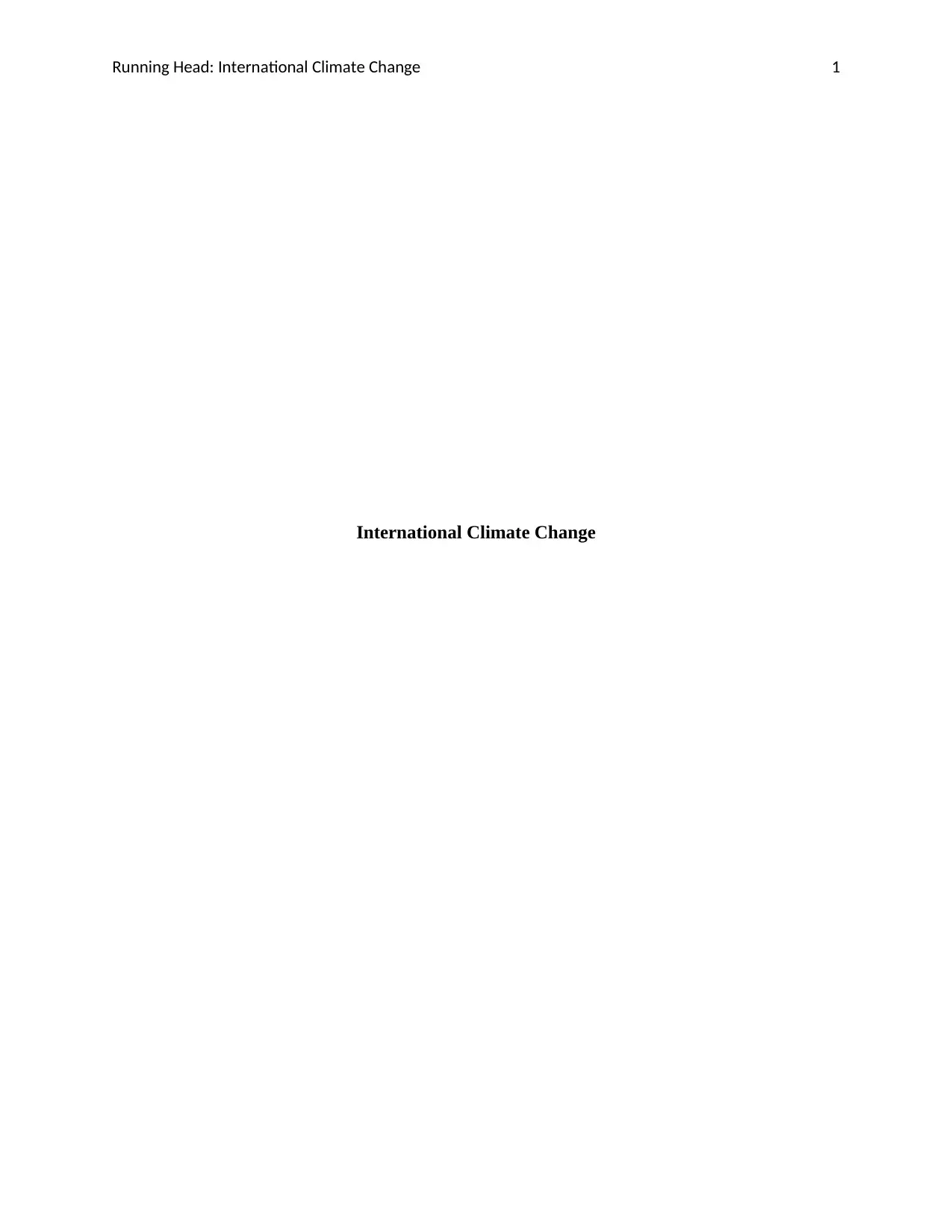
Running Head: International Climate Change 1
International Climate Change
International Climate Change
Paraphrase This Document
Need a fresh take? Get an instant paraphrase of this document with our AI Paraphraser
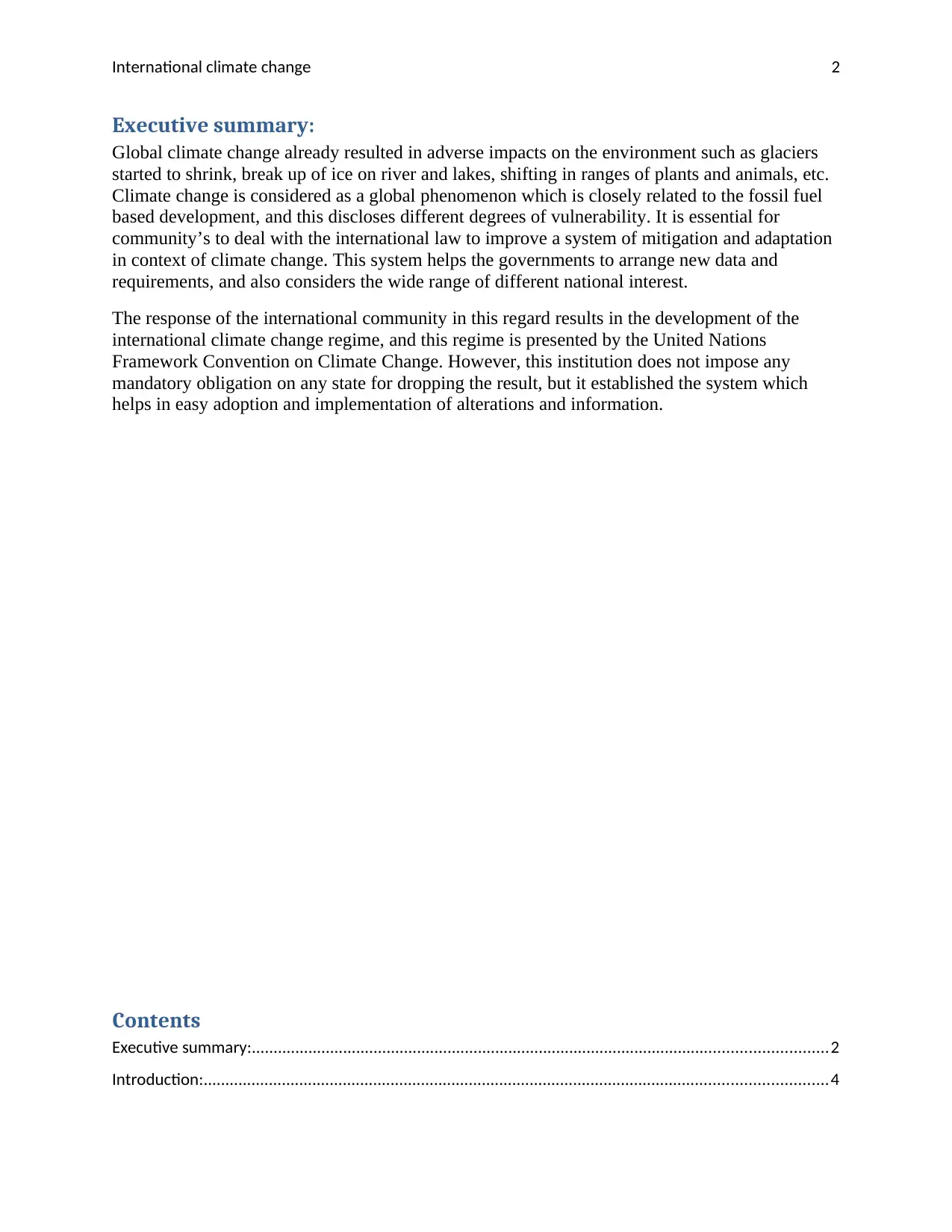
International climate change 2
Executive summary:
Global climate change already resulted in adverse impacts on the environment such as glaciers
started to shrink, break up of ice on river and lakes, shifting in ranges of plants and animals, etc.
Climate change is considered as a global phenomenon which is closely related to the fossil fuel
based development, and this discloses different degrees of vulnerability. It is essential for
community’s to deal with the international law to improve a system of mitigation and adaptation
in context of climate change. This system helps the governments to arrange new data and
requirements, and also considers the wide range of different national interest.
The response of the international community in this regard results in the development of the
international climate change regime, and this regime is presented by the United Nations
Framework Convention on Climate Change. However, this institution does not impose any
mandatory obligation on any state for dropping the result, but it established the system which
helps in easy adoption and implementation of alterations and information.
Contents
Executive summary:....................................................................................................................................2
Introduction:...............................................................................................................................................4
Executive summary:
Global climate change already resulted in adverse impacts on the environment such as glaciers
started to shrink, break up of ice on river and lakes, shifting in ranges of plants and animals, etc.
Climate change is considered as a global phenomenon which is closely related to the fossil fuel
based development, and this discloses different degrees of vulnerability. It is essential for
community’s to deal with the international law to improve a system of mitigation and adaptation
in context of climate change. This system helps the governments to arrange new data and
requirements, and also considers the wide range of different national interest.
The response of the international community in this regard results in the development of the
international climate change regime, and this regime is presented by the United Nations
Framework Convention on Climate Change. However, this institution does not impose any
mandatory obligation on any state for dropping the result, but it established the system which
helps in easy adoption and implementation of alterations and information.
Contents
Executive summary:....................................................................................................................................2
Introduction:...............................................................................................................................................4
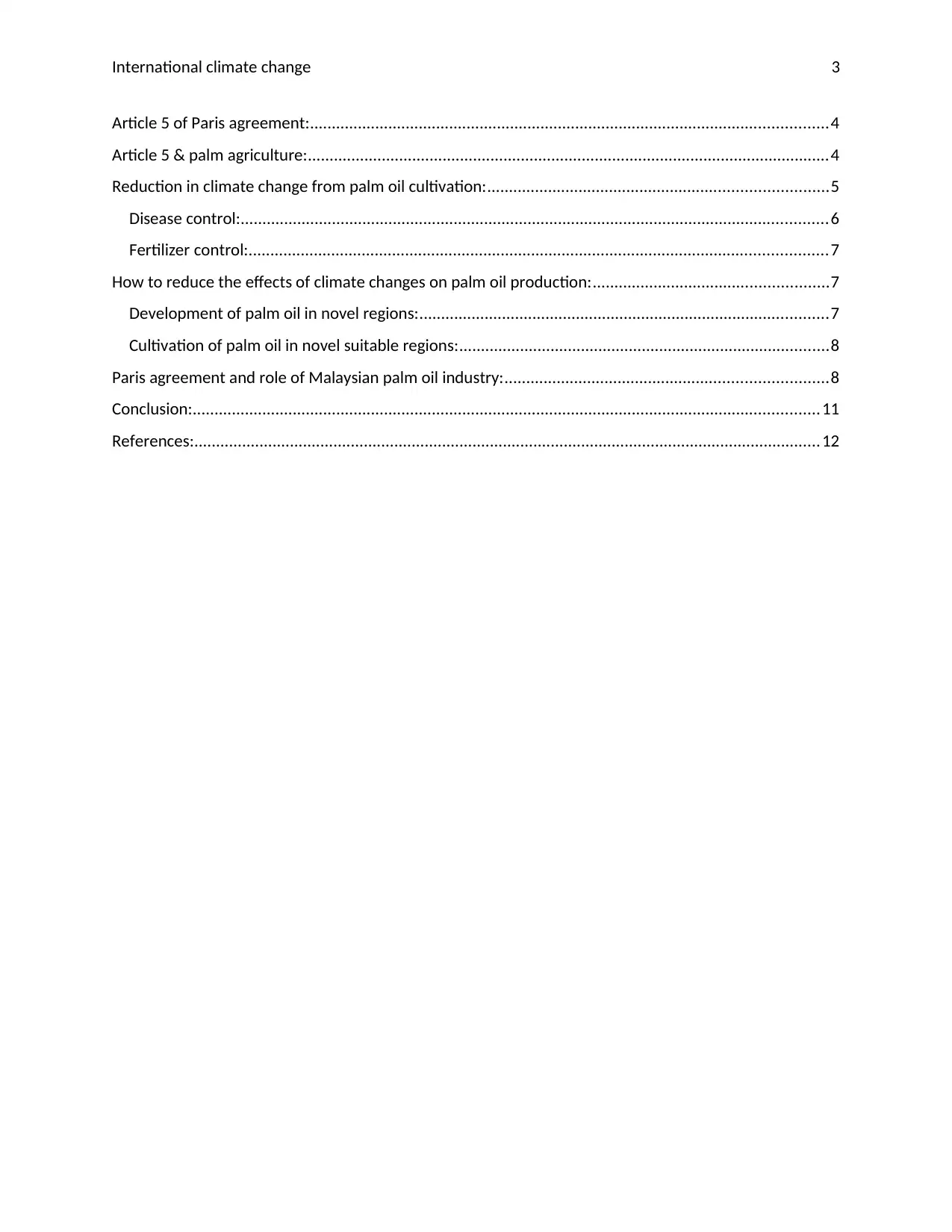
International climate change 3
Article 5 of Paris agreement:.......................................................................................................................4
Article 5 & palm agriculture:........................................................................................................................4
Reduction in climate change from palm oil cultivation:..............................................................................5
Disease control:.......................................................................................................................................6
Fertilizer control:.....................................................................................................................................7
How to reduce the effects of climate changes on palm oil production:......................................................7
Development of palm oil in novel regions:..............................................................................................7
Cultivation of palm oil in novel suitable regions:.....................................................................................8
Paris agreement and role of Malaysian palm oil industry:..........................................................................8
Conclusion:................................................................................................................................................11
References:................................................................................................................................................12
Article 5 of Paris agreement:.......................................................................................................................4
Article 5 & palm agriculture:........................................................................................................................4
Reduction in climate change from palm oil cultivation:..............................................................................5
Disease control:.......................................................................................................................................6
Fertilizer control:.....................................................................................................................................7
How to reduce the effects of climate changes on palm oil production:......................................................7
Development of palm oil in novel regions:..............................................................................................7
Cultivation of palm oil in novel suitable regions:.....................................................................................8
Paris agreement and role of Malaysian palm oil industry:..........................................................................8
Conclusion:................................................................................................................................................11
References:................................................................................................................................................12
⊘ This is a preview!⊘
Do you want full access?
Subscribe today to unlock all pages.

Trusted by 1+ million students worldwide
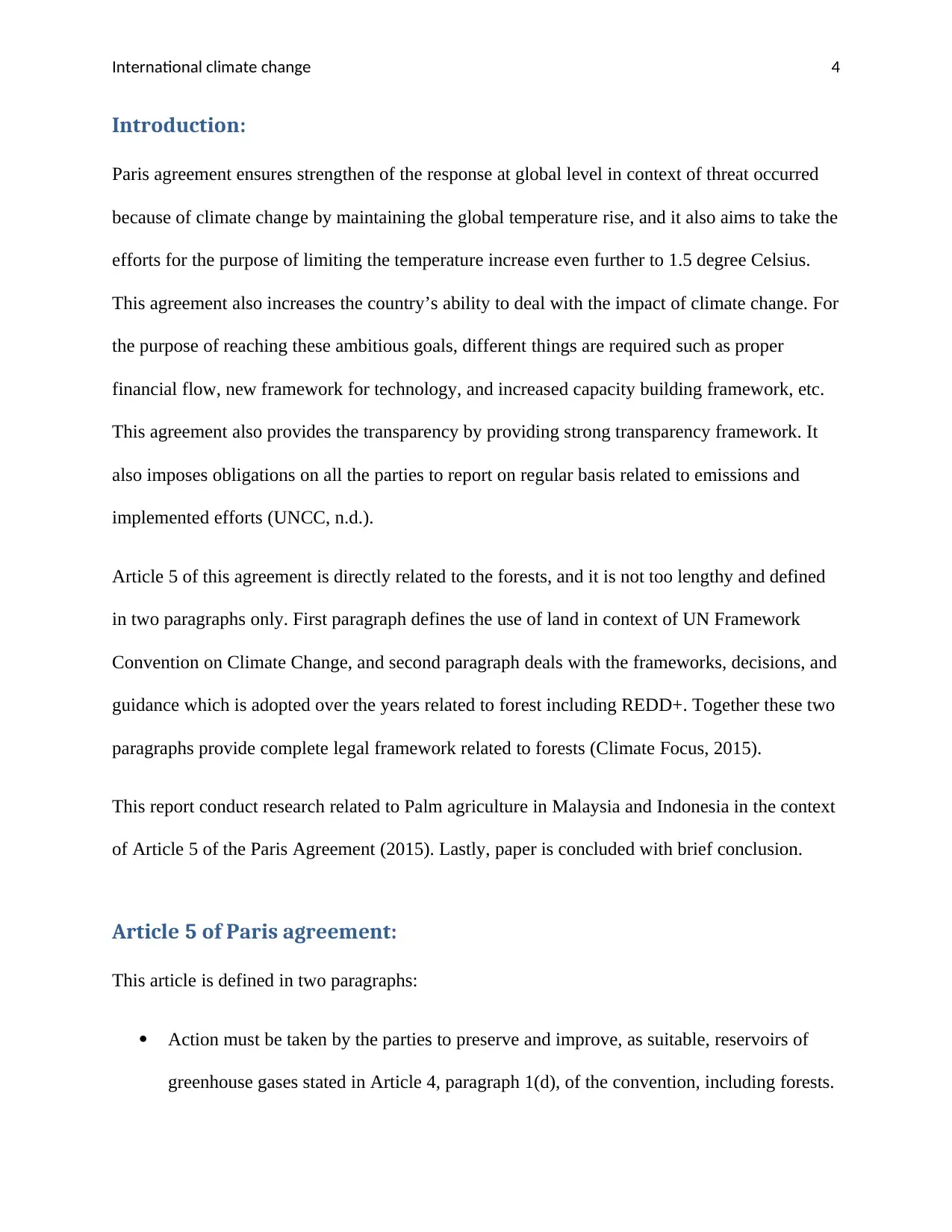
International climate change 4
Introduction:
Paris agreement ensures strengthen of the response at global level in context of threat occurred
because of climate change by maintaining the global temperature rise, and it also aims to take the
efforts for the purpose of limiting the temperature increase even further to 1.5 degree Celsius.
This agreement also increases the country’s ability to deal with the impact of climate change. For
the purpose of reaching these ambitious goals, different things are required such as proper
financial flow, new framework for technology, and increased capacity building framework, etc.
This agreement also provides the transparency by providing strong transparency framework. It
also imposes obligations on all the parties to report on regular basis related to emissions and
implemented efforts (UNCC, n.d.).
Article 5 of this agreement is directly related to the forests, and it is not too lengthy and defined
in two paragraphs only. First paragraph defines the use of land in context of UN Framework
Convention on Climate Change, and second paragraph deals with the frameworks, decisions, and
guidance which is adopted over the years related to forest including REDD+. Together these two
paragraphs provide complete legal framework related to forests (Climate Focus, 2015).
This report conduct research related to Palm agriculture in Malaysia and Indonesia in the context
of Article 5 of the Paris Agreement (2015). Lastly, paper is concluded with brief conclusion.
Article 5 of Paris agreement:
This article is defined in two paragraphs:
Action must be taken by the parties to preserve and improve, as suitable, reservoirs of
greenhouse gases stated in Article 4, paragraph 1(d), of the convention, including forests.
Introduction:
Paris agreement ensures strengthen of the response at global level in context of threat occurred
because of climate change by maintaining the global temperature rise, and it also aims to take the
efforts for the purpose of limiting the temperature increase even further to 1.5 degree Celsius.
This agreement also increases the country’s ability to deal with the impact of climate change. For
the purpose of reaching these ambitious goals, different things are required such as proper
financial flow, new framework for technology, and increased capacity building framework, etc.
This agreement also provides the transparency by providing strong transparency framework. It
also imposes obligations on all the parties to report on regular basis related to emissions and
implemented efforts (UNCC, n.d.).
Article 5 of this agreement is directly related to the forests, and it is not too lengthy and defined
in two paragraphs only. First paragraph defines the use of land in context of UN Framework
Convention on Climate Change, and second paragraph deals with the frameworks, decisions, and
guidance which is adopted over the years related to forest including REDD+. Together these two
paragraphs provide complete legal framework related to forests (Climate Focus, 2015).
This report conduct research related to Palm agriculture in Malaysia and Indonesia in the context
of Article 5 of the Paris Agreement (2015). Lastly, paper is concluded with brief conclusion.
Article 5 of Paris agreement:
This article is defined in two paragraphs:
Action must be taken by the parties to preserve and improve, as suitable, reservoirs of
greenhouse gases stated in Article 4, paragraph 1(d), of the convention, including forests.
Paraphrase This Document
Need a fresh take? Get an instant paraphrase of this document with our AI Paraphraser
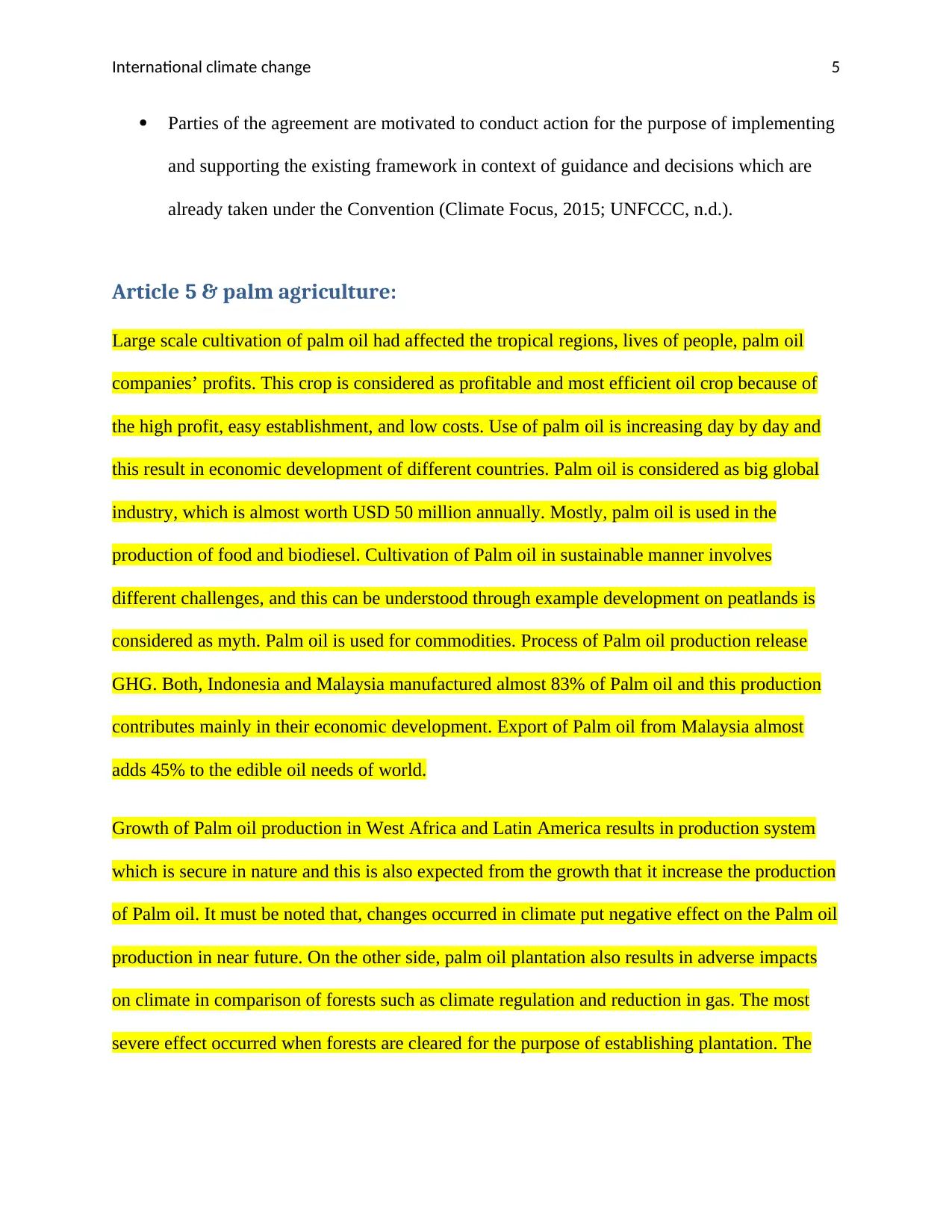
International climate change 5
Parties of the agreement are motivated to conduct action for the purpose of implementing
and supporting the existing framework in context of guidance and decisions which are
already taken under the Convention (Climate Focus, 2015; UNFCCC, n.d.).
Article 5 & palm agriculture:
Large scale cultivation of palm oil had affected the tropical regions, lives of people, palm oil
companies’ profits. This crop is considered as profitable and most efficient oil crop because of
the high profit, easy establishment, and low costs. Use of palm oil is increasing day by day and
this result in economic development of different countries. Palm oil is considered as big global
industry, which is almost worth USD 50 million annually. Mostly, palm oil is used in the
production of food and biodiesel. Cultivation of Palm oil in sustainable manner involves
different challenges, and this can be understood through example development on peatlands is
considered as myth. Palm oil is used for commodities. Process of Palm oil production release
GHG. Both, Indonesia and Malaysia manufactured almost 83% of Palm oil and this production
contributes mainly in their economic development. Export of Palm oil from Malaysia almost
adds 45% to the edible oil needs of world.
Growth of Palm oil production in West Africa and Latin America results in production system
which is secure in nature and this is also expected from the growth that it increase the production
of Palm oil. It must be noted that, changes occurred in climate put negative effect on the Palm oil
production in near future. On the other side, palm oil plantation also results in adverse impacts
on climate in comparison of forests such as climate regulation and reduction in gas. The most
severe effect occurred when forests are cleared for the purpose of establishing plantation. The
Parties of the agreement are motivated to conduct action for the purpose of implementing
and supporting the existing framework in context of guidance and decisions which are
already taken under the Convention (Climate Focus, 2015; UNFCCC, n.d.).
Article 5 & palm agriculture:
Large scale cultivation of palm oil had affected the tropical regions, lives of people, palm oil
companies’ profits. This crop is considered as profitable and most efficient oil crop because of
the high profit, easy establishment, and low costs. Use of palm oil is increasing day by day and
this result in economic development of different countries. Palm oil is considered as big global
industry, which is almost worth USD 50 million annually. Mostly, palm oil is used in the
production of food and biodiesel. Cultivation of Palm oil in sustainable manner involves
different challenges, and this can be understood through example development on peatlands is
considered as myth. Palm oil is used for commodities. Process of Palm oil production release
GHG. Both, Indonesia and Malaysia manufactured almost 83% of Palm oil and this production
contributes mainly in their economic development. Export of Palm oil from Malaysia almost
adds 45% to the edible oil needs of world.
Growth of Palm oil production in West Africa and Latin America results in production system
which is secure in nature and this is also expected from the growth that it increase the production
of Palm oil. It must be noted that, changes occurred in climate put negative effect on the Palm oil
production in near future. On the other side, palm oil plantation also results in adverse impacts
on climate in comparison of forests such as climate regulation and reduction in gas. The most
severe effect occurred when forests are cleared for the purpose of establishing plantation. The
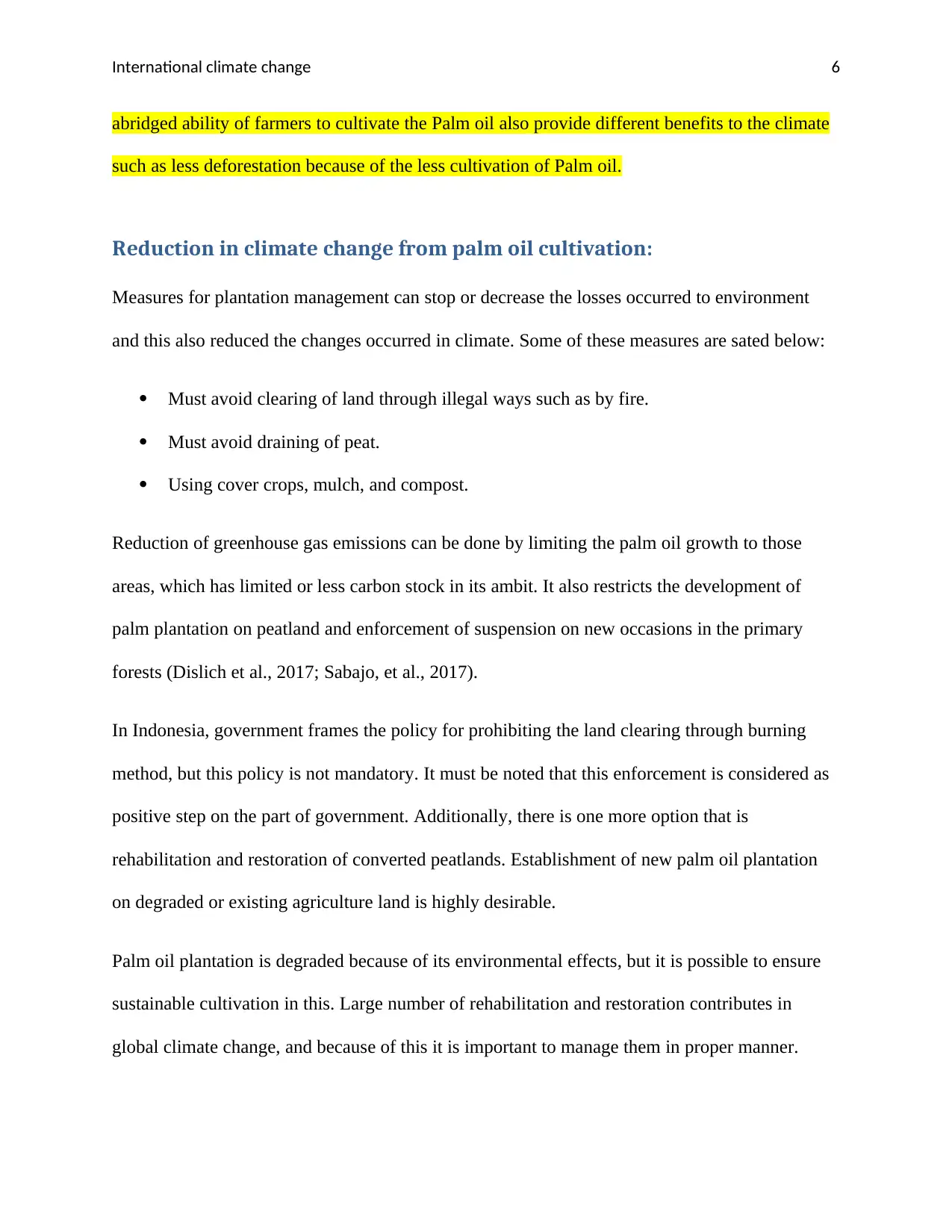
International climate change 6
abridged ability of farmers to cultivate the Palm oil also provide different benefits to the climate
such as less deforestation because of the less cultivation of Palm oil.
Reduction in climate change from palm oil cultivation:
Measures for plantation management can stop or decrease the losses occurred to environment
and this also reduced the changes occurred in climate. Some of these measures are sated below:
Must avoid clearing of land through illegal ways such as by fire.
Must avoid draining of peat.
Using cover crops, mulch, and compost.
Reduction of greenhouse gas emissions can be done by limiting the palm oil growth to those
areas, which has limited or less carbon stock in its ambit. It also restricts the development of
palm plantation on peatland and enforcement of suspension on new occasions in the primary
forests (Dislich et al., 2017; Sabajo, et al., 2017).
In Indonesia, government frames the policy for prohibiting the land clearing through burning
method, but this policy is not mandatory. It must be noted that this enforcement is considered as
positive step on the part of government. Additionally, there is one more option that is
rehabilitation and restoration of converted peatlands. Establishment of new palm oil plantation
on degraded or existing agriculture land is highly desirable.
Palm oil plantation is degraded because of its environmental effects, but it is possible to ensure
sustainable cultivation in this. Large number of rehabilitation and restoration contributes in
global climate change, and because of this it is important to manage them in proper manner.
abridged ability of farmers to cultivate the Palm oil also provide different benefits to the climate
such as less deforestation because of the less cultivation of Palm oil.
Reduction in climate change from palm oil cultivation:
Measures for plantation management can stop or decrease the losses occurred to environment
and this also reduced the changes occurred in climate. Some of these measures are sated below:
Must avoid clearing of land through illegal ways such as by fire.
Must avoid draining of peat.
Using cover crops, mulch, and compost.
Reduction of greenhouse gas emissions can be done by limiting the palm oil growth to those
areas, which has limited or less carbon stock in its ambit. It also restricts the development of
palm plantation on peatland and enforcement of suspension on new occasions in the primary
forests (Dislich et al., 2017; Sabajo, et al., 2017).
In Indonesia, government frames the policy for prohibiting the land clearing through burning
method, but this policy is not mandatory. It must be noted that this enforcement is considered as
positive step on the part of government. Additionally, there is one more option that is
rehabilitation and restoration of converted peatlands. Establishment of new palm oil plantation
on degraded or existing agriculture land is highly desirable.
Palm oil plantation is degraded because of its environmental effects, but it is possible to ensure
sustainable cultivation in this. Large number of rehabilitation and restoration contributes in
global climate change, and because of this it is important to manage them in proper manner.
⊘ This is a preview!⊘
Do you want full access?
Subscribe today to unlock all pages.

Trusted by 1+ million students worldwide
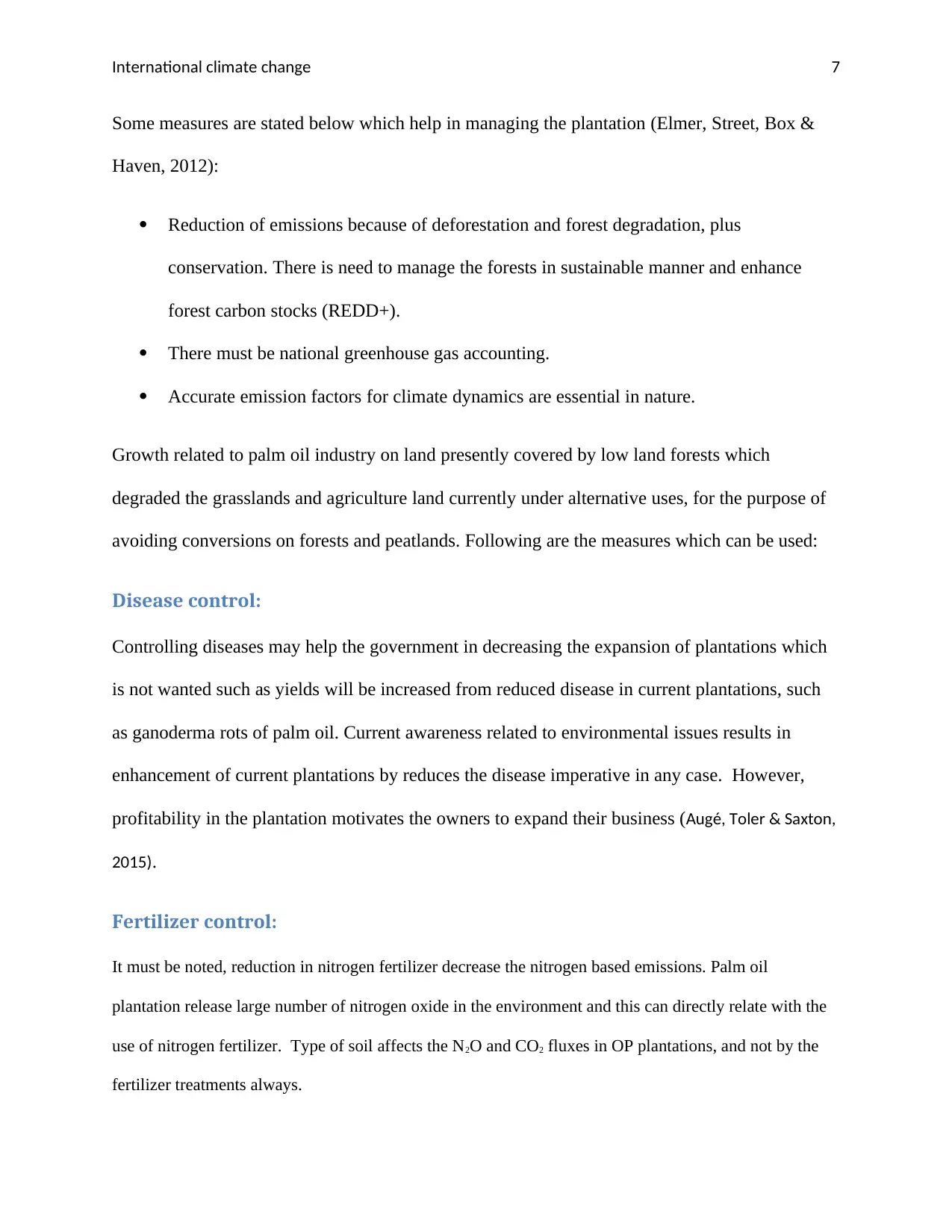
International climate change 7
Some measures are stated below which help in managing the plantation (Elmer, Street, Box &
Haven, 2012):
Reduction of emissions because of deforestation and forest degradation, plus
conservation. There is need to manage the forests in sustainable manner and enhance
forest carbon stocks (REDD+).
There must be national greenhouse gas accounting.
Accurate emission factors for climate dynamics are essential in nature.
Growth related to palm oil industry on land presently covered by low land forests which
degraded the grasslands and agriculture land currently under alternative uses, for the purpose of
avoiding conversions on forests and peatlands. Following are the measures which can be used:
Disease control:
Controlling diseases may help the government in decreasing the expansion of plantations which
is not wanted such as yields will be increased from reduced disease in current plantations, such
as ganoderma rots of palm oil. Current awareness related to environmental issues results in
enhancement of current plantations by reduces the disease imperative in any case. However,
profitability in the plantation motivates the owners to expand their business (Augé, Toler & Saxton,
2015).
Fertilizer control:
It must be noted, reduction in nitrogen fertilizer decrease the nitrogen based emissions. Palm oil
plantation release large number of nitrogen oxide in the environment and this can directly relate with the
use of nitrogen fertilizer. Type of soil affects the N2O and CO2 fluxes in OP plantations, and not by the
fertilizer treatments always.
Some measures are stated below which help in managing the plantation (Elmer, Street, Box &
Haven, 2012):
Reduction of emissions because of deforestation and forest degradation, plus
conservation. There is need to manage the forests in sustainable manner and enhance
forest carbon stocks (REDD+).
There must be national greenhouse gas accounting.
Accurate emission factors for climate dynamics are essential in nature.
Growth related to palm oil industry on land presently covered by low land forests which
degraded the grasslands and agriculture land currently under alternative uses, for the purpose of
avoiding conversions on forests and peatlands. Following are the measures which can be used:
Disease control:
Controlling diseases may help the government in decreasing the expansion of plantations which
is not wanted such as yields will be increased from reduced disease in current plantations, such
as ganoderma rots of palm oil. Current awareness related to environmental issues results in
enhancement of current plantations by reduces the disease imperative in any case. However,
profitability in the plantation motivates the owners to expand their business (Augé, Toler & Saxton,
2015).
Fertilizer control:
It must be noted, reduction in nitrogen fertilizer decrease the nitrogen based emissions. Palm oil
plantation release large number of nitrogen oxide in the environment and this can directly relate with the
use of nitrogen fertilizer. Type of soil affects the N2O and CO2 fluxes in OP plantations, and not by the
fertilizer treatments always.
Paraphrase This Document
Need a fresh take? Get an instant paraphrase of this document with our AI Paraphraser
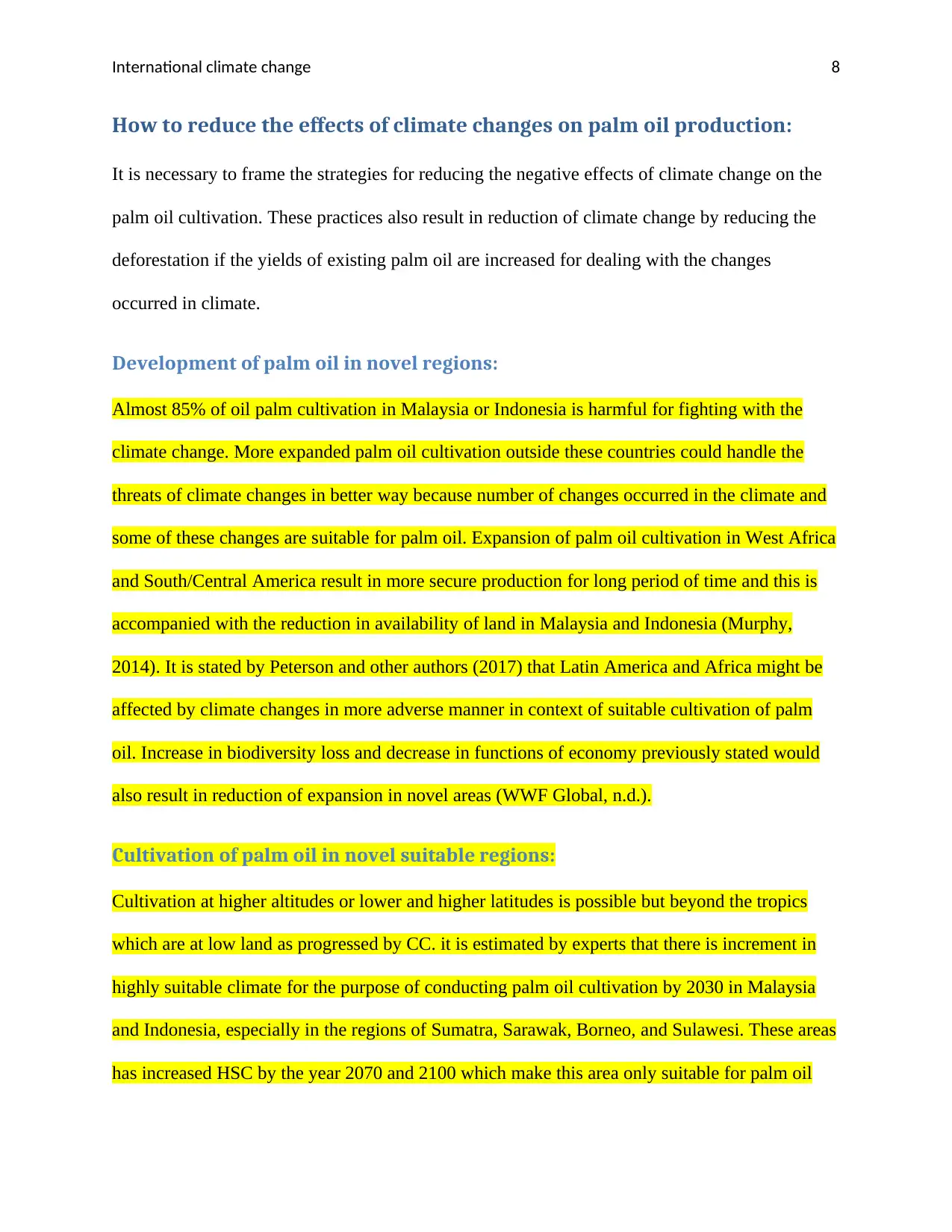
International climate change 8
How to reduce the effects of climate changes on palm oil production:
It is necessary to frame the strategies for reducing the negative effects of climate change on the
palm oil cultivation. These practices also result in reduction of climate change by reducing the
deforestation if the yields of existing palm oil are increased for dealing with the changes
occurred in climate.
Development of palm oil in novel regions:
Almost 85% of oil palm cultivation in Malaysia or Indonesia is harmful for fighting with the
climate change. More expanded palm oil cultivation outside these countries could handle the
threats of climate changes in better way because number of changes occurred in the climate and
some of these changes are suitable for palm oil. Expansion of palm oil cultivation in West Africa
and South/Central America result in more secure production for long period of time and this is
accompanied with the reduction in availability of land in Malaysia and Indonesia (Murphy,
2014). It is stated by Peterson and other authors (2017) that Latin America and Africa might be
affected by climate changes in more adverse manner in context of suitable cultivation of palm
oil. Increase in biodiversity loss and decrease in functions of economy previously stated would
also result in reduction of expansion in novel areas (WWF Global, n.d.).
Cultivation of palm oil in novel suitable regions:
Cultivation at higher altitudes or lower and higher latitudes is possible but beyond the tropics
which are at low land as progressed by CC. it is estimated by experts that there is increment in
highly suitable climate for the purpose of conducting palm oil cultivation by 2030 in Malaysia
and Indonesia, especially in the regions of Sumatra, Sarawak, Borneo, and Sulawesi. These areas
has increased HSC by the year 2070 and 2100 which make this area only suitable for palm oil
How to reduce the effects of climate changes on palm oil production:
It is necessary to frame the strategies for reducing the negative effects of climate change on the
palm oil cultivation. These practices also result in reduction of climate change by reducing the
deforestation if the yields of existing palm oil are increased for dealing with the changes
occurred in climate.
Development of palm oil in novel regions:
Almost 85% of oil palm cultivation in Malaysia or Indonesia is harmful for fighting with the
climate change. More expanded palm oil cultivation outside these countries could handle the
threats of climate changes in better way because number of changes occurred in the climate and
some of these changes are suitable for palm oil. Expansion of palm oil cultivation in West Africa
and South/Central America result in more secure production for long period of time and this is
accompanied with the reduction in availability of land in Malaysia and Indonesia (Murphy,
2014). It is stated by Peterson and other authors (2017) that Latin America and Africa might be
affected by climate changes in more adverse manner in context of suitable cultivation of palm
oil. Increase in biodiversity loss and decrease in functions of economy previously stated would
also result in reduction of expansion in novel areas (WWF Global, n.d.).
Cultivation of palm oil in novel suitable regions:
Cultivation at higher altitudes or lower and higher latitudes is possible but beyond the tropics
which are at low land as progressed by CC. it is estimated by experts that there is increment in
highly suitable climate for the purpose of conducting palm oil cultivation by 2030 in Malaysia
and Indonesia, especially in the regions of Sumatra, Sarawak, Borneo, and Sulawesi. These areas
has increased HSC by the year 2070 and 2100 which make this area only suitable for palm oil
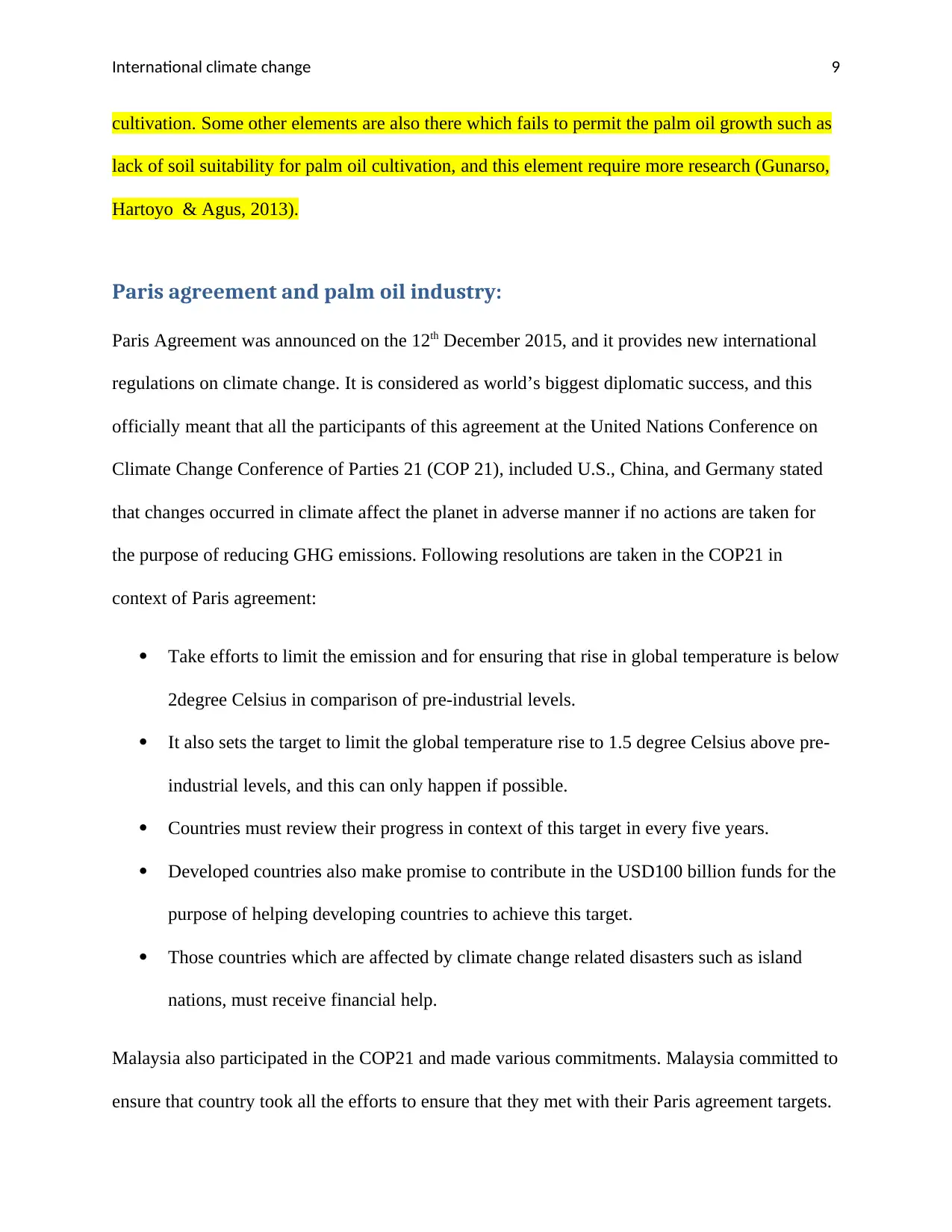
International climate change 9
cultivation. Some other elements are also there which fails to permit the palm oil growth such as
lack of soil suitability for palm oil cultivation, and this element require more research (Gunarso,
Hartoyo & Agus, 2013).
Paris agreement and palm oil industry:
Paris Agreement was announced on the 12th December 2015, and it provides new international
regulations on climate change. It is considered as world’s biggest diplomatic success, and this
officially meant that all the participants of this agreement at the United Nations Conference on
Climate Change Conference of Parties 21 (COP 21), included U.S., China, and Germany stated
that changes occurred in climate affect the planet in adverse manner if no actions are taken for
the purpose of reducing GHG emissions. Following resolutions are taken in the COP21 in
context of Paris agreement:
Take efforts to limit the emission and for ensuring that rise in global temperature is below
2degree Celsius in comparison of pre-industrial levels.
It also sets the target to limit the global temperature rise to 1.5 degree Celsius above pre-
industrial levels, and this can only happen if possible.
Countries must review their progress in context of this target in every five years.
Developed countries also make promise to contribute in the USD100 billion funds for the
purpose of helping developing countries to achieve this target.
Those countries which are affected by climate change related disasters such as island
nations, must receive financial help.
Malaysia also participated in the COP21 and made various commitments. Malaysia committed to
ensure that country took all the efforts to ensure that they met with their Paris agreement targets.
cultivation. Some other elements are also there which fails to permit the palm oil growth such as
lack of soil suitability for palm oil cultivation, and this element require more research (Gunarso,
Hartoyo & Agus, 2013).
Paris agreement and palm oil industry:
Paris Agreement was announced on the 12th December 2015, and it provides new international
regulations on climate change. It is considered as world’s biggest diplomatic success, and this
officially meant that all the participants of this agreement at the United Nations Conference on
Climate Change Conference of Parties 21 (COP 21), included U.S., China, and Germany stated
that changes occurred in climate affect the planet in adverse manner if no actions are taken for
the purpose of reducing GHG emissions. Following resolutions are taken in the COP21 in
context of Paris agreement:
Take efforts to limit the emission and for ensuring that rise in global temperature is below
2degree Celsius in comparison of pre-industrial levels.
It also sets the target to limit the global temperature rise to 1.5 degree Celsius above pre-
industrial levels, and this can only happen if possible.
Countries must review their progress in context of this target in every five years.
Developed countries also make promise to contribute in the USD100 billion funds for the
purpose of helping developing countries to achieve this target.
Those countries which are affected by climate change related disasters such as island
nations, must receive financial help.
Malaysia also participated in the COP21 and made various commitments. Malaysia committed to
ensure that country took all the efforts to ensure that they met with their Paris agreement targets.
⊘ This is a preview!⊘
Do you want full access?
Subscribe today to unlock all pages.

Trusted by 1+ million students worldwide
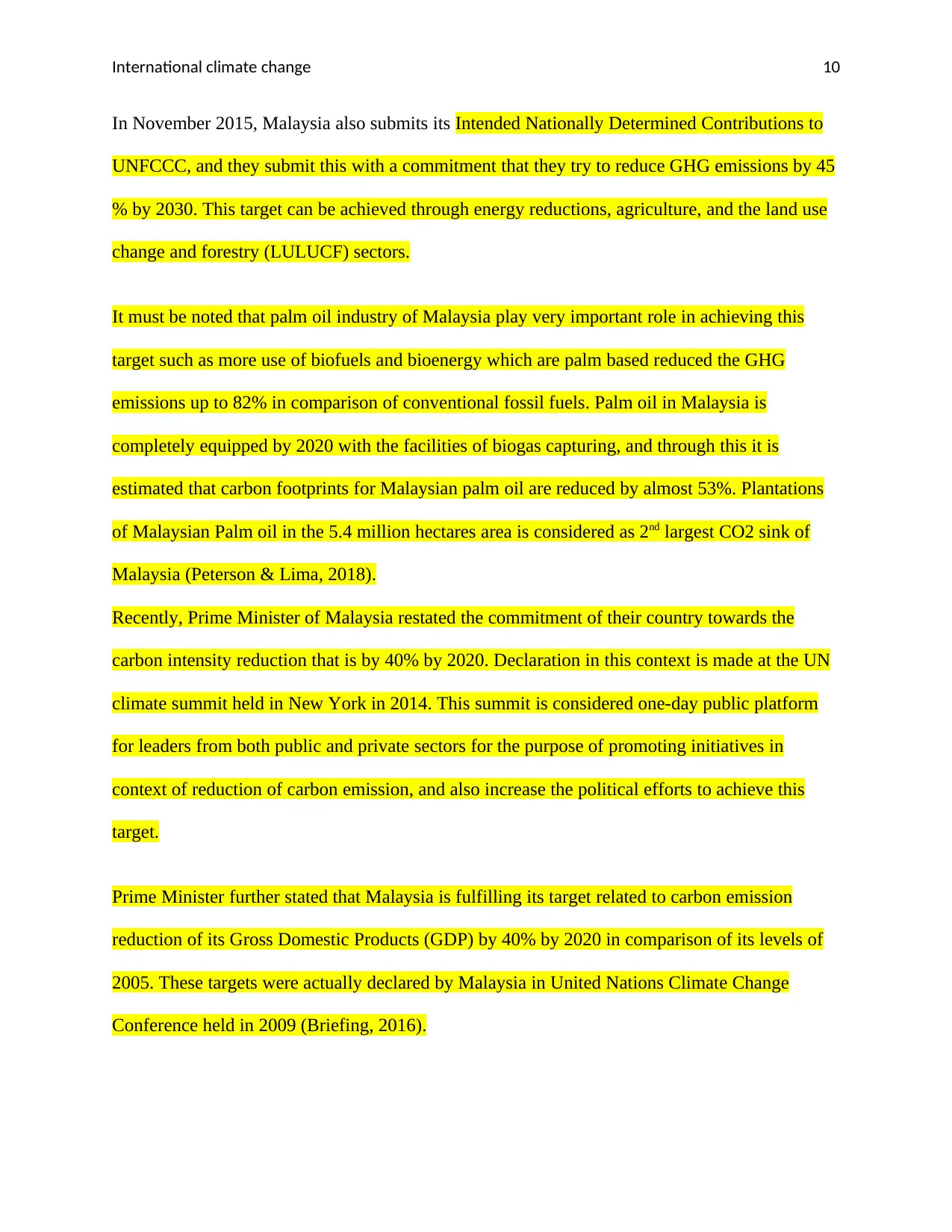
International climate change 10
In November 2015, Malaysia also submits its Intended Nationally Determined Contributions to
UNFCCC, and they submit this with a commitment that they try to reduce GHG emissions by 45
% by 2030. This target can be achieved through energy reductions, agriculture, and the land use
change and forestry (LULUCF) sectors.
It must be noted that palm oil industry of Malaysia play very important role in achieving this
target such as more use of biofuels and bioenergy which are palm based reduced the GHG
emissions up to 82% in comparison of conventional fossil fuels. Palm oil in Malaysia is
completely equipped by 2020 with the facilities of biogas capturing, and through this it is
estimated that carbon footprints for Malaysian palm oil are reduced by almost 53%. Plantations
of Malaysian Palm oil in the 5.4 million hectares area is considered as 2nd largest CO2 sink of
Malaysia (Peterson & Lima, 2018).
Recently, Prime Minister of Malaysia restated the commitment of their country towards the
carbon intensity reduction that is by 40% by 2020. Declaration in this context is made at the UN
climate summit held in New York in 2014. This summit is considered one-day public platform
for leaders from both public and private sectors for the purpose of promoting initiatives in
context of reduction of carbon emission, and also increase the political efforts to achieve this
target.
Prime Minister further stated that Malaysia is fulfilling its target related to carbon emission
reduction of its Gross Domestic Products (GDP) by 40% by 2020 in comparison of its levels of
2005. These targets were actually declared by Malaysia in United Nations Climate Change
Conference held in 2009 (Briefing, 2016).
In November 2015, Malaysia also submits its Intended Nationally Determined Contributions to
UNFCCC, and they submit this with a commitment that they try to reduce GHG emissions by 45
% by 2030. This target can be achieved through energy reductions, agriculture, and the land use
change and forestry (LULUCF) sectors.
It must be noted that palm oil industry of Malaysia play very important role in achieving this
target such as more use of biofuels and bioenergy which are palm based reduced the GHG
emissions up to 82% in comparison of conventional fossil fuels. Palm oil in Malaysia is
completely equipped by 2020 with the facilities of biogas capturing, and through this it is
estimated that carbon footprints for Malaysian palm oil are reduced by almost 53%. Plantations
of Malaysian Palm oil in the 5.4 million hectares area is considered as 2nd largest CO2 sink of
Malaysia (Peterson & Lima, 2018).
Recently, Prime Minister of Malaysia restated the commitment of their country towards the
carbon intensity reduction that is by 40% by 2020. Declaration in this context is made at the UN
climate summit held in New York in 2014. This summit is considered one-day public platform
for leaders from both public and private sectors for the purpose of promoting initiatives in
context of reduction of carbon emission, and also increase the political efforts to achieve this
target.
Prime Minister further stated that Malaysia is fulfilling its target related to carbon emission
reduction of its Gross Domestic Products (GDP) by 40% by 2020 in comparison of its levels of
2005. These targets were actually declared by Malaysia in United Nations Climate Change
Conference held in 2009 (Briefing, 2016).
Paraphrase This Document
Need a fresh take? Get an instant paraphrase of this document with our AI Paraphraser
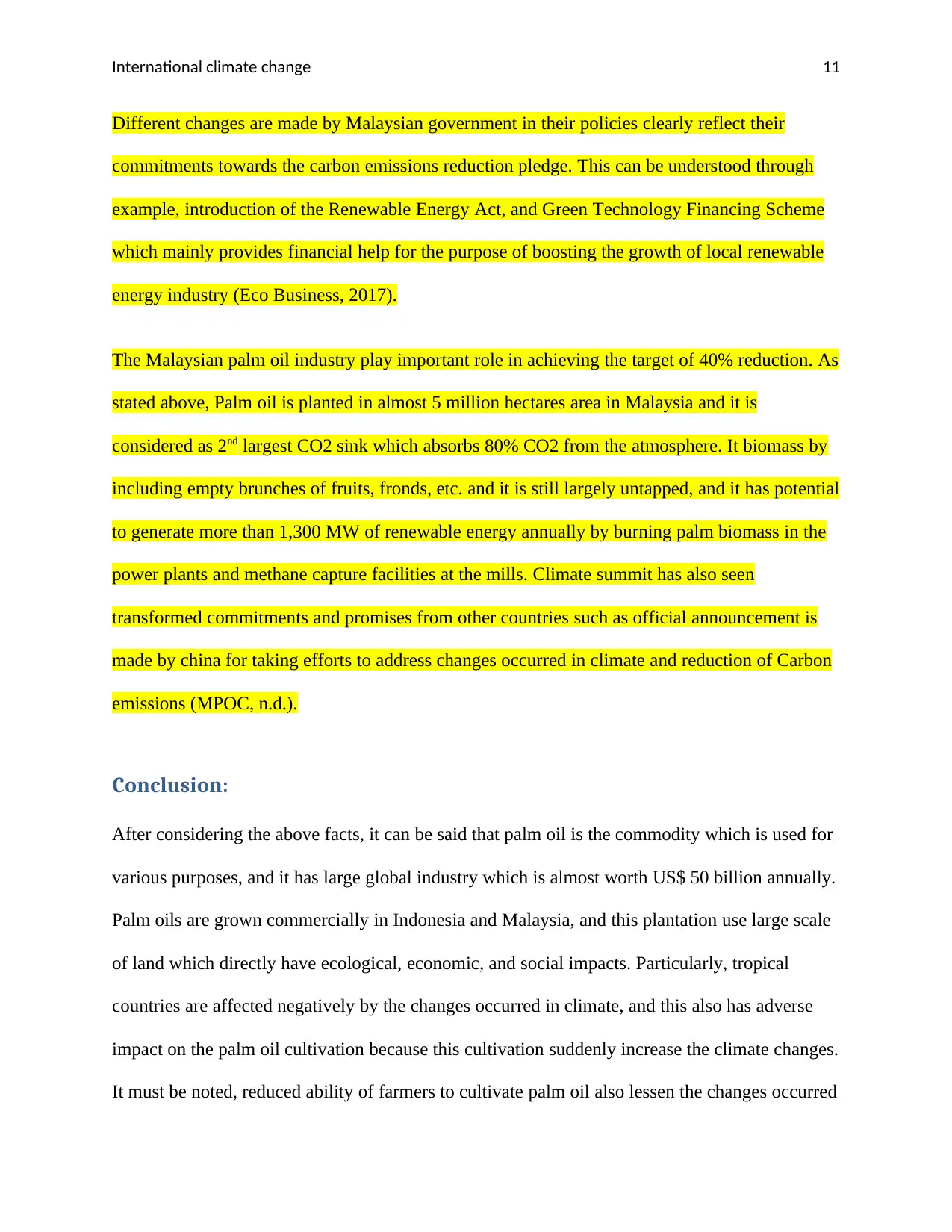
International climate change 11
Different changes are made by Malaysian government in their policies clearly reflect their
commitments towards the carbon emissions reduction pledge. This can be understood through
example, introduction of the Renewable Energy Act, and Green Technology Financing Scheme
which mainly provides financial help for the purpose of boosting the growth of local renewable
energy industry (Eco Business, 2017).
The Malaysian palm oil industry play important role in achieving the target of 40% reduction. As
stated above, Palm oil is planted in almost 5 million hectares area in Malaysia and it is
considered as 2nd largest CO2 sink which absorbs 80% CO2 from the atmosphere. It biomass by
including empty brunches of fruits, fronds, etc. and it is still largely untapped, and it has potential
to generate more than 1,300 MW of renewable energy annually by burning palm biomass in the
power plants and methane capture facilities at the mills. Climate summit has also seen
transformed commitments and promises from other countries such as official announcement is
made by china for taking efforts to address changes occurred in climate and reduction of Carbon
emissions (MPOC, n.d.).
Conclusion:
After considering the above facts, it can be said that palm oil is the commodity which is used for
various purposes, and it has large global industry which is almost worth US$ 50 billion annually.
Palm oils are grown commercially in Indonesia and Malaysia, and this plantation use large scale
of land which directly have ecological, economic, and social impacts. Particularly, tropical
countries are affected negatively by the changes occurred in climate, and this also has adverse
impact on the palm oil cultivation because this cultivation suddenly increase the climate changes.
It must be noted, reduced ability of farmers to cultivate palm oil also lessen the changes occurred
Different changes are made by Malaysian government in their policies clearly reflect their
commitments towards the carbon emissions reduction pledge. This can be understood through
example, introduction of the Renewable Energy Act, and Green Technology Financing Scheme
which mainly provides financial help for the purpose of boosting the growth of local renewable
energy industry (Eco Business, 2017).
The Malaysian palm oil industry play important role in achieving the target of 40% reduction. As
stated above, Palm oil is planted in almost 5 million hectares area in Malaysia and it is
considered as 2nd largest CO2 sink which absorbs 80% CO2 from the atmosphere. It biomass by
including empty brunches of fruits, fronds, etc. and it is still largely untapped, and it has potential
to generate more than 1,300 MW of renewable energy annually by burning palm biomass in the
power plants and methane capture facilities at the mills. Climate summit has also seen
transformed commitments and promises from other countries such as official announcement is
made by china for taking efforts to address changes occurred in climate and reduction of Carbon
emissions (MPOC, n.d.).
Conclusion:
After considering the above facts, it can be said that palm oil is the commodity which is used for
various purposes, and it has large global industry which is almost worth US$ 50 billion annually.
Palm oils are grown commercially in Indonesia and Malaysia, and this plantation use large scale
of land which directly have ecological, economic, and social impacts. Particularly, tropical
countries are affected negatively by the changes occurred in climate, and this also has adverse
impact on the palm oil cultivation because this cultivation suddenly increase the climate changes.
It must be noted, reduced ability of farmers to cultivate palm oil also lessen the changes occurred
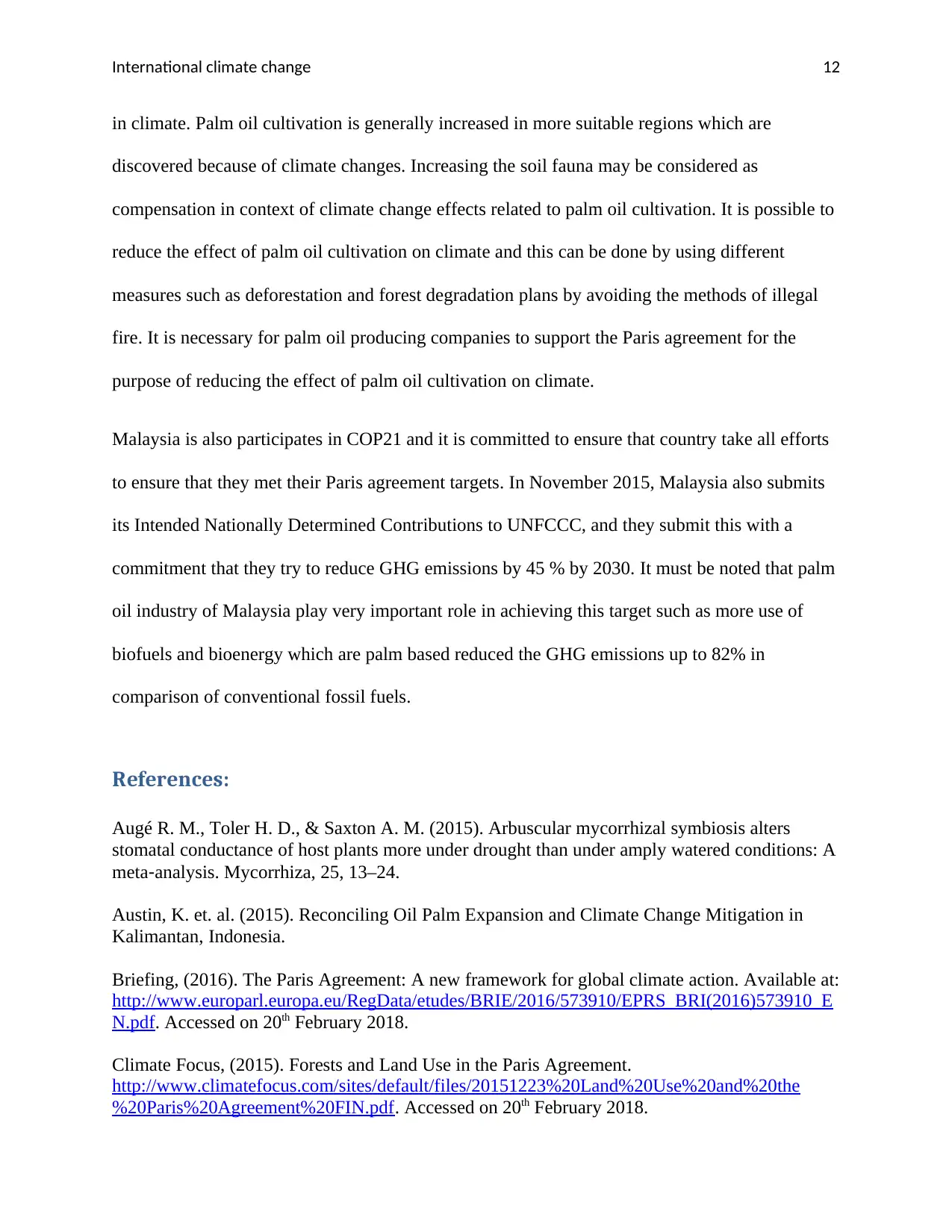
International climate change 12
in climate. Palm oil cultivation is generally increased in more suitable regions which are
discovered because of climate changes. Increasing the soil fauna may be considered as
compensation in context of climate change effects related to palm oil cultivation. It is possible to
reduce the effect of palm oil cultivation on climate and this can be done by using different
measures such as deforestation and forest degradation plans by avoiding the methods of illegal
fire. It is necessary for palm oil producing companies to support the Paris agreement for the
purpose of reducing the effect of palm oil cultivation on climate.
Malaysia is also participates in COP21 and it is committed to ensure that country take all efforts
to ensure that they met their Paris agreement targets. In November 2015, Malaysia also submits
its Intended Nationally Determined Contributions to UNFCCC, and they submit this with a
commitment that they try to reduce GHG emissions by 45 % by 2030. It must be noted that palm
oil industry of Malaysia play very important role in achieving this target such as more use of
biofuels and bioenergy which are palm based reduced the GHG emissions up to 82% in
comparison of conventional fossil fuels.
References:
Augé R. M., Toler H. D., & Saxton A. M. (2015). Arbuscular mycorrhizal symbiosis alters
stomatal conductance of host plants more under drought than under amply watered conditions: A
meta‐analysis. Mycorrhiza, 25, 13–24.
Austin, K. et. al. (2015). Reconciling Oil Palm Expansion and Climate Change Mitigation in
Kalimantan, Indonesia.
Briefing, (2016). The Paris Agreement: A new framework for global climate action. Available at:
http://www.europarl.europa.eu/RegData/etudes/BRIE/2016/573910/EPRS_BRI(2016)573910_E
N.pdf. Accessed on 20th February 2018.
Climate Focus, (2015). Forests and Land Use in the Paris Agreement.
http://www.climatefocus.com/sites/default/files/20151223%20Land%20Use%20and%20the
%20Paris%20Agreement%20FIN.pdf. Accessed on 20th February 2018.
in climate. Palm oil cultivation is generally increased in more suitable regions which are
discovered because of climate changes. Increasing the soil fauna may be considered as
compensation in context of climate change effects related to palm oil cultivation. It is possible to
reduce the effect of palm oil cultivation on climate and this can be done by using different
measures such as deforestation and forest degradation plans by avoiding the methods of illegal
fire. It is necessary for palm oil producing companies to support the Paris agreement for the
purpose of reducing the effect of palm oil cultivation on climate.
Malaysia is also participates in COP21 and it is committed to ensure that country take all efforts
to ensure that they met their Paris agreement targets. In November 2015, Malaysia also submits
its Intended Nationally Determined Contributions to UNFCCC, and they submit this with a
commitment that they try to reduce GHG emissions by 45 % by 2030. It must be noted that palm
oil industry of Malaysia play very important role in achieving this target such as more use of
biofuels and bioenergy which are palm based reduced the GHG emissions up to 82% in
comparison of conventional fossil fuels.
References:
Augé R. M., Toler H. D., & Saxton A. M. (2015). Arbuscular mycorrhizal symbiosis alters
stomatal conductance of host plants more under drought than under amply watered conditions: A
meta‐analysis. Mycorrhiza, 25, 13–24.
Austin, K. et. al. (2015). Reconciling Oil Palm Expansion and Climate Change Mitigation in
Kalimantan, Indonesia.
Briefing, (2016). The Paris Agreement: A new framework for global climate action. Available at:
http://www.europarl.europa.eu/RegData/etudes/BRIE/2016/573910/EPRS_BRI(2016)573910_E
N.pdf. Accessed on 20th February 2018.
Climate Focus, (2015). Forests and Land Use in the Paris Agreement.
http://www.climatefocus.com/sites/default/files/20151223%20Land%20Use%20and%20the
%20Paris%20Agreement%20FIN.pdf. Accessed on 20th February 2018.
⊘ This is a preview!⊘
Do you want full access?
Subscribe today to unlock all pages.

Trusted by 1+ million students worldwide
1 out of 14
Related Documents
Your All-in-One AI-Powered Toolkit for Academic Success.
+13062052269
info@desklib.com
Available 24*7 on WhatsApp / Email
![[object Object]](/_next/static/media/star-bottom.7253800d.svg)
Unlock your academic potential
Copyright © 2020–2025 A2Z Services. All Rights Reserved. Developed and managed by ZUCOL.





